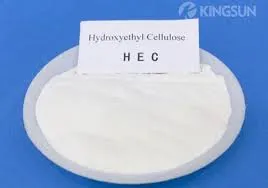
Nov . 29, 2024 11:15 Back to list
Hydroxyethylcellulose Applications and Benefits in Modern Industries and Products
Hydroxyethylcellulose-Based Materials An Overview of Applications and Benefits
Hydroxyethylcellulose (HEC) is a non-ionic, water-soluble polymer derived from cellulose. It is formed through the etherification of cellulose with ethylene oxide. This modification imparts unique properties to cellulose, significantly enhancing its functionality in various applications. Given its versatility and effectiveness, HEC has gained remarkable attention in pharmaceutical, cosmetic, and industrial applications. This article aims to explore the benefits, applications, and future potential of hydroxyethylcellulose-based materials.
Advantages of Hydroxyethylcellulose
One of the most significant advantages of HEC is its exceptional thickening and gelling properties, making it an ideal ingredient in many formulations. HEC provides viscosity without altering the clarity of products, which is particularly beneficial in cosmetics and personal care items such as lotions, creams, and shampoos. Unlike many other thickening agents, HEC is stable across a broad pH range, making it suitable for diverse formulations.
Moreover, hydroxyethylcellulose is recognized for its excellent water retention capabilities. This property not only enhances hydration in skincare products but also plays a vital role in maintaining the right moisture levels in various applications. Additionally, HEC is biocompatible and non-toxic, making it an attractive option for sensitive skin formulations and pharmaceutical applications. This ease of incorporation into various matrices allows formulators to create products that are both effective and safe for consumers.
Applications in Pharmaceuticals
In the pharmaceutical industry, HEC is primarily used as an excipient. It functions as a binder, thickener, and stabilizer in a variety of dosage forms, including gels, ointments, and suspensions. The ability of HEC to dissolve in water and create viscous solutions makes it particularly useful in topical formulations, where it enhances the spreadability and stability of active ingredients.
Furthermore, HEC is employed in controlled-release formulations due to its ability to regulate the release of drugs over time. By modifying the molecular weight and concentration of HEC in formulations, pharmaceutical developers can tailor the release profile of medications, thereby improving their efficacy and patient compliance.
Cosmetic and Personal Care Products
The beauty and personal care industry has also witnessed a surge in the utilization of hydroxyethylcellulose due to its functional properties. As a thickening agent, HEC is widely used in shampoos, conditioners, and skin creams, enhancing texture and feel. Its water-binding properties help in retaining moisture, making it a preferred ingredient in moisturizing formulations.
hydroxyethylcellulose based

Moreover, HEC increases product stability and shelf life by preventing the separation of ingredients, contributing to a more uniform product. Its transparent gel appearance is suited for clear formulations, making it a go-to choice for manufacturers aiming to create visually appealing products.
Industrial Applications
Beyond the cosmetic and pharmaceutical sectors, HEC is also utilized in various industrial applications. In the construction industry, hydroxyethylcellulose is incorporated into adhesives, sealants, and cement-based products. It acts as a thickener and improves the workability of cement pastes, allowing for greater ease of application. Moreover, HEC contributes to the adhesion properties of these materials without compromising performance.
In agriculture, HEC is used as a soil conditioner and additive for controlled-release fertilizers. Its ability to retain moisture helps protect plants during dry spells, enhancing crop yields and sustainability.
Future Perspectives
With growing consumer interest in natural and sustainable products, HEC's role is expanding. Its natural origin and biodegradable nature make it an ideal candidate for eco-friendly formulations. As regulatory environments evolve and demand for sustainability increases, hydroxyethylcellulose will be pivotal in meeting these new standards.
Research on enhancing the properties of HEC, including modifications to improve its functionality and performance, is also ongoing. This could lead to the development of more advanced formulations and applications across various fields.
Conclusion
Hydroxyethylcellulose-based materials exemplify the intersection of innovation, safety, and versatility across numerous industries. With its unique properties, HEC continues to play a crucial role in developing effective and safe products in pharmaceuticals, cosmetics, and industrial applications. As researchers and manufacturers explore further modifications and applications of this valuable polymer, the future looks promising for hydroxyethylcellulose in enhancing both consumer products and industrial processes.
-
Versatile Hpmc Uses in Different Industries
NewsJun.19,2025
-
Redispersible Powder's Role in Enhancing Durability of Construction Products
NewsJun.19,2025
-
Hydroxyethyl Cellulose Applications Driving Green Industrial Processes
NewsJun.19,2025
-
Exploring Different Redispersible Polymer Powder
NewsJun.19,2025
-
Choosing the Right Mortar Bonding Agent
NewsJun.19,2025
-
Applications and Significance of China Hpmc in Modern Industries
NewsJun.19,2025







